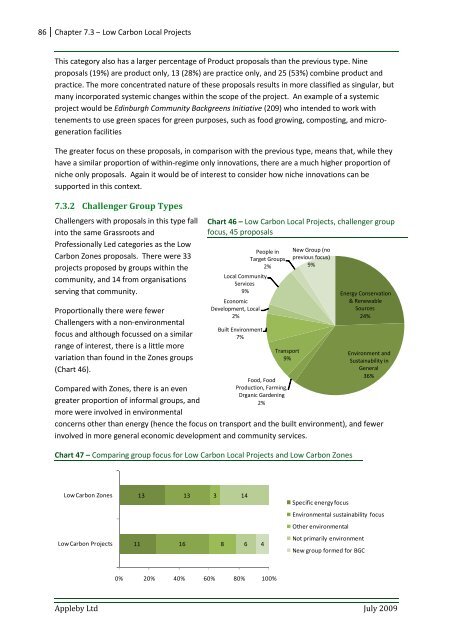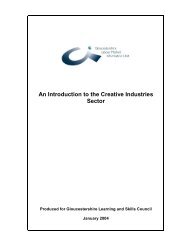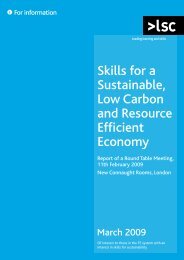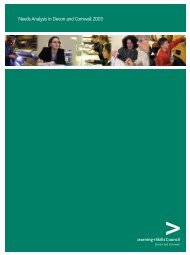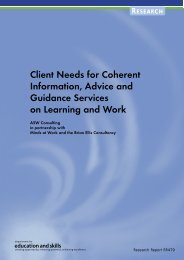Mapping the Big Green Challenge - The Skills & Learning ...
Mapping the Big Green Challenge - The Skills & Learning ...
Mapping the Big Green Challenge - The Skills & Learning ...
Create successful ePaper yourself
Turn your PDF publications into a flip-book with our unique Google optimized e-Paper software.
86 Chapter 7.3 – Low Carbon Local ProjectsThis category also has a larger percentage of Product proposals than <strong>the</strong> previous type. Nineproposals (19%) are product only, 13 (28%) are practice only, and 25 (53%) combine product andpractice. <strong>The</strong> more concentrated nature of <strong>the</strong>se proposals results in more classified as singular, butmany incorporated systemic changes within <strong>the</strong> scope of <strong>the</strong> project. An example of a systemicproject would be Edinburgh Community Backgreens Initiative (209) who intended to work withtenements to use green spaces for green purposes, such as food growing, composting, and microgenerationfacilities<strong>The</strong> greater focus on <strong>the</strong>se proposals, in comparison with <strong>the</strong> previous type, means that, while <strong>the</strong>yhave a similar proportion of within-regime only innovations, <strong>the</strong>re are a much higher proportion ofniche only proposals. Again it would be of interest to consider how niche innovations can besupported in this context.7.3.2 <strong>Challenge</strong>r Group Types<strong>Challenge</strong>rs with proposals in this type fallinto <strong>the</strong> same Grassroots andProfessionally Led categories as <strong>the</strong> LowCarbon Zones proposals. <strong>The</strong>re were 33projects proposed by groups within <strong>the</strong>community, and 14 from organisationsserving that community.Proportionally <strong>the</strong>re were fewer<strong>Challenge</strong>rs with a non-environmentalfocus and although focussed on a similarrange of interest, <strong>the</strong>re is a little morevariation than found in <strong>the</strong> Zones groups(Chart 46).Compared with Zones, <strong>the</strong>re is an evengreater proportion of informal groups, andmore were involved in environmentalChart 46 – Low Carbon Local Projects, challenger groupfocus, 45 proposalsLocal CommunityServices9%EconomicDevelopment, Local2%Built Environment7%People inTarget Groups2%Transport9%Food, FoodProduction, Farming,Organic Gardening2%New Group (noprevious focus)9%concerns o<strong>the</strong>r than energy (hence <strong>the</strong> focus on transport and <strong>the</strong> built environment), and fewerinvolved in more general economic development and community services.Chart 47 – Comparing group focus for Low Carbon Local Projects and Low Carbon ZonesEnergy Conservation& RenewableSources24%Environment andSustainability inGeneral36%Low Carbon Zones1313314Specific energy focusEnvironmental sustainability focusO<strong>the</strong>r environmentalLow Carbon Projects1116864Not primarily environmentNew group formed for BGC0% 20% 40% 60% 80% 100%Appleby Ltd July 2009


